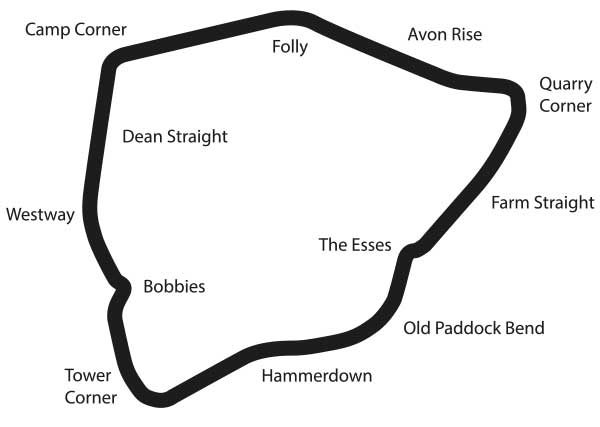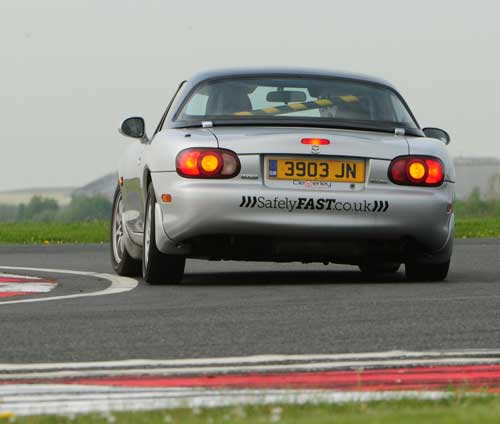Castle Combe Circuit
by John Norrington
Castle Combe Circuit opened in 1950. Happily the 1.964 miles of tarmac remain ‘old school’ in nature. This is in spite of the addition of the two chicanes added in 1999 to slow things down as 100mph plus laps had by then been attained. There are five main corners but simple as that sounds, the barriers are never far away. It probably provides the closest racing in UK motorsport with tense, high speed, streamlining battles commonplace. The hugely popular Bank Holiday meetings need early planning by both competitors and spectators as space is at a premium everywhere. The banking that overlooks the circuit offers some of the closest viewing available anywhere. This is not a place for the faint hearted and its style is unusual today so should be approached initially with a degree of care.

The accuracy of any guide like this will depend upon the car that is being driven and can only ever be general in nature but in any car this circuit provides a high speed challenge. This is borne out by the statistics, starting with the flat-out approach to the first corner combination of Avon Rise and Quarry, considered by many to be amongst the hardest in the country. A feature of Combe is the bumpy surface which suits a softer set up for many race cars. It was recently resurfaced but rather than removing the bumps, it appears to have moved them. Together with its high speeds this amounts to a challenging, technical and demanding circuit.
Avon Rise / Quarry Corner
This section has to be looked at as a combination. The flat out approach through the kink at Folly leads at maximum speed into Avon Rise facing the driver with a big decision – when and where to brake. A mistake here will be costly. Will you brake before the crest and ease over it? Or brake much harder afterwards when the car has settled? This and the line you choose will largely be governed by the car you are driving. The late-brakers will be more likely to carry a straighter faster line towards the apex of Quarry, whilst the lighter, handier, grippier and less powerful machines will usually choose the wider more traditional line to the left carrying more speed through the corner although travelling a greater distance.
The Esses / Old Paddock
From Quarry the Farm Straight leads into the Esses. Here a smooth entry carrying speed through the first right hand apex (with maybe some smooth braking and use of the flat kerbing) holds speed to the second and sharper left hand apex. The exit from the apex is important as it is the start of a long fast section through Old Paddock corner and power should be held all the way via Hammerdown to the next challenge at Tower corner.
Tower Corner
Strong braking is needed here and the road falls downhill too, so as you cross the brow look for an earlier than expected turn for what is actually a fairly late apex. This is to cross the camber early which otherwise pulls you wide. Then hug the kerb to find the apex itself where there is a drain cover when the road rises a little, after which let the car run out midway along the visible exit kerb.
Bobbies / Westway
Having just exited Tower you are fast approaching the second chicane so look hard for the apex at Bobbies which is suddenly upon you. A firm brake is needed despite the slight brow in the road. This starts with a fairly sharp turn in and then quickly another to the second apex on the left and braking can usefully be carried deep into the corner here. The car must then be allowed to run to a wide exit but take care not to overshoot. Too much enthusiasm now will spoil the exit onto Westway and yet another long straight with time easily lost recovering things. Slower in faster out is good.
Camp Corner
Westway leads on to Dean Straight and the massively important and daunting corner at Camp which is key to the very long rush down to Avon/Quarry corner. This one is all about a strong exit to show up on the stopwatch – probably the most important corner for a good lap time at Combe. Shortly after the pit entry on the left the road dips and is noticeably bumpy. This is the start of the corner entry which should not be rushed, and for speed and safety the car must be kept balanced into this exciting corner where spins are often seen. The apparent apex point should be missed by a full car’s width and instantly the real apex will appear. Then the power should be hard on well before reaching the apex and then the car should be allowed to run long and wide with Combe’s unique orange marshalls tower offering a good sighting point to finish your ultra fast lap.
Enjoy!
John Norrington Experience
- 10+ years hands on teaching experience
- c.5,000 pupils to date
- Race licence holder over 40 years
- ARDS GRADE A Instructor
- MSA Level 2 Coach
- APDI member
- IAM member
- ATDO
- RoSPA member
- SDSA certified
- Pro Driver. Worked with many manufacturers/dealers, staff and customers on road and track driving, demonstrating and training.
Links:

Safely Fast’s Mazda MX5







